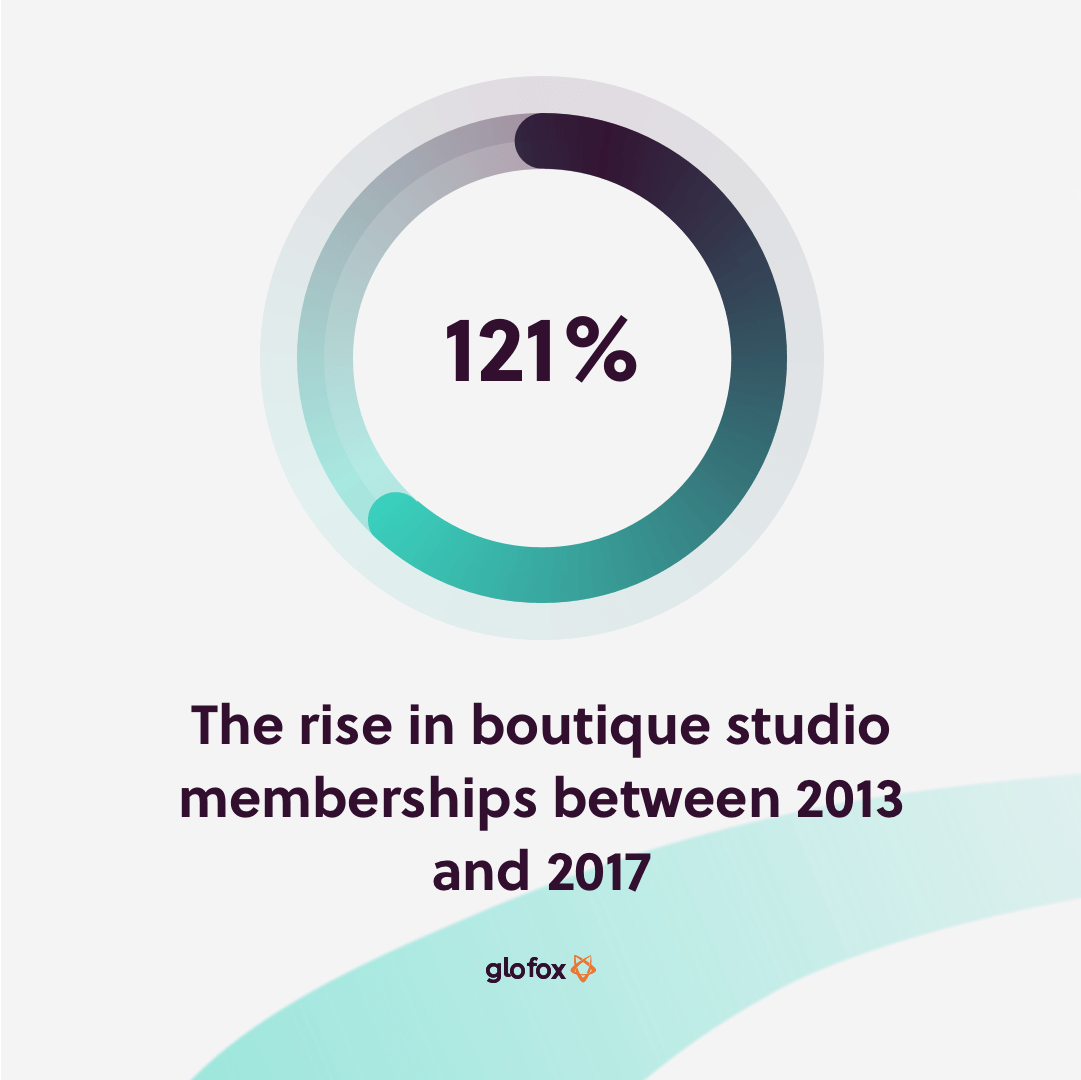The fitness industry is booming and is showing no signs of slowing down. If you think that means fierce competition, then you’d be right. But there’s enough business for everyone, which is why there has never been a better time to get into the fitness industry.

To put things in perspective, the global fitness industry is now worth almost $100 billion and there are now over 210,000 fitness and health clubs internationally. But the growth is also in part due to the explosion of boutique gyms around the world. There has been a 121% rise in boutique gym memberships between 2013 and 2017.
The US alone accounts for $38 billion of the $100 billion pie and is home to almost 40,000 health and fitness clubs. On top of that figure, you have to add all the boutique studios, community recreation facilities and other venues with a gym, such as hotels.
So what’s the reason for this growth spurt? And how can you get in on the action in the new year? We’ve put this guide together to help you understand the fitness industry and how you can become a part of it.
Skip ahead to:
Why the Fitness Industry is Booming
Facts and figures look great, but what are the underlying causes of this relentless boom in the fitness industry? There are quite a few reasons. Technology has enabled people more access and greater insights, and the competition between gyms has also made it more affordable.
1. Fitness Wearables
Fitbit and Apple Watch are popular examples of fitness wearables that give people more insight into their personal health. They can see how many steps they’ve taken each day and how many calories they’ve burned. They can also log their food and water intake to keep track of their eating habits.
This increased awareness has led people to think more about their diet and fitness. The wearables can work as a motivator or guilt trip, depending on what works best. But the bottom line is that they drive more people to sign up for a gym membership or join a class.
2. Health Insurance Incentives
Insurance companies have for years encouraged their clients to adopt a healthy lifestyle. That practice has been augmented by the introduction of fitness wearables because it allows the insurance companies to track the activity of their clients to calculate their discounts.
Everyone knows they should eat healthy food and exercise regularly, but it doesn’t hurt to have a monetary incentive as well. And the cost of joining a gym or attending an exercise class is easily offset by the savings on your health insurance policy.
2. Demand for Healthy Foods
Exercise and diet go hand in hand. Processed foods are out, and organic foods are in. Millennials are particularly conscious about what they put in their bodies. And that also makes them consider other ways in which they can maintain their shape and good health.
Gyms and fitness outlets have quickly asserted themselves as authorities on the subject of healthy eating. And every personal trainer will tell you that a healthy diet is as important a part of your fitness regimen as the exercises themselves.
4. Live-streamed Classes
Another technology that has boosted the fitness industry is live streaming. People who travel a lot or have an unpredictable schedule may not want to be tied to a specific gym location. That’s why there has been such a huge interest in live-streamed fitness classes.
It’s not detrimental to physical gyms, because those people wouldn’t have attended anyway. But it’s a blessing for online fitness businesses. There is now a whole new industry of fitness subscription apps that people can use to stream classes from home. And you can get in on it.
5. Affordable Fitness Options
Although high-end gyms are usually frequented by high-income earners, a new category of gyms has sprung up to accommodate the lower- and middle-income earners. The HVLP (“high value, low price”) gyms make different types of exercise affordable to everyone.
Affordability is one of the key reasons why the fitness industry is booming. It just makes financial sense: if more people can afford a gym class, then more people will attend. The average gym membership was around $40 in 2014. Today you can get one for as little as $10.
How to Be Successful in the Fitness Industry in 2020

You’ve seen the numbers and you understand the reasons why there has never been a better time to get into the fitness industry. Now it’s time to look at some actionable ways for you to enter the industry in the new year.
1. Find a Good Location
Build it and they will come — but only if you build it well and in a convenient location. The location for your gym business should have high ceilings and natural light. It should also have enough space to fit in the exercise machines and still have room for open-space sessions.
It should also be easy for your members to get to, so make sure there are good public transportation links and parking options. Finally, it’s also a good idea to research the local competition. You don’t want to open a gym in an area that is already oversaturated.
2. Join a Fitness Franchise
Does the prospect of starting your own gym business with minimal support seem daunting to you? Don’t worry, there are alternatives to starting from scratch. There are a number of large fitness franchises on the market and they’re looking for new franchisees to partner with.
If you can’t beat ‘em, join ‘em. The fitness franchise sector is experiencing rapid growth at the moment, so now is a good time to open your own branch. You’ll enjoy support when it comes to pretty much every facet of your business: location, marketing, products, services, and management.
The Top 10 Barriers
Slowing Your Fitness
Business Growth
Discover more 3. Have a Marketing Strategy
You’ll also need a solid marketing strategy so you can get the word out. How you promote your gym business should depend on your target audience. If you’re targeting Millennials, then email and social media is the way to go. Or, if you cater to a senior audience, then consider direct mail.
If your gym business is part of a larger franchise, then your marketing efforts might be limited by their guidelines. But it could also work in your favor. Large franchises tend to have big marketing budgets, and you can save yourself a lot of time, money, and work if they do the heavy lifting.
4. Secure Funding
Whether you’re running a solo operation or a franchise, you’ll need to secure funding for your gym business. You can apply for a small business loan at the bank or try to court some investors. But either way, you’ll likely need to account for the investment with a business plan.
Calculate all your costs and try to make a predictive analysis of the revenue you will generate. You can also strengthen your position by finding a business partner who brings different skills to the table. Or you could seek sponsorship from an established fitness brand to help with funding.
5. Offer the Right Services
The services you offer at your gym business need to be relevant to your target audience. If your customers are businesses or their employees, then offer them corporate programs. If you’re in the business of yoga, then your members will appreciate additional mindfulness classes.
Here are some ideas for services you can offer:
- Custom meal plans.
- Fitness assessments.
- Guided meditation.
- Nutrition workshops.
- Personal training.
- Gym space rental.
- Special events.
Which services appeal to your customers will depend on the type of gym business you run.
6. Sell the Right Products
As with services, you can generate additional revenue by selling health and fitness related products from your gym business. In addition to the meal plans and nutrition workshops, you can sell the individual food items that you promote with your services. That way, you’re offering a holistic experience.
Here are some products that you can sell at your gym:
- Bottled water.
- Boxing wraps.
- Food recipes.
- Padlocks.
- Protein shakes and bars.
- Toiletries.
- Weightlifting gloves.
You can even create your own branded fitness products for extra brand awareness and better profit margins.
7. Capitalize on Fitness Trends
There are many new fitness trends you can take advantage of when you’re designing your gym business. Some of them will be specific to certain demographics, so remember to do a proper analysis of your target market before you commit to a specific fitness trend.
Here are some examples of Millennial fitness trends you can capitalize on:
- On-demand classes.
- Influencer marketing.
- Live-streamed sessions.
- Functional training.
- Micro-HIIT sessions.
- Mindfulness training.
9. Get Certified
If you run a small gym business with limited resources, then you might have to put in some work in the gym yourself. You don’t have to attend school for years to get the right certification. Many websites offer online courses that you can complete in your own time while managing your business.
Find out how to become a fitness instructor so you don’t have to rely on outsourcing to accommodate your gym members. It’s also a great way to understand the inner workings of your gym business when you do get the capacity to outsource the training aspect.
8. Educate Yourself
Learning doesn’t stop once you get certified. The fitness industry moves very quickly, and it would be unwise to not educate yourself continuously. Fortunately, there are many great blogs on fitness you can subscribe to so you’re up to date on the latest trends to follow.
But fitness trends are only half the story. Many of the blogs appeal to the gym-goers themselves, and you have a business to run. That’s why you should also subscribe to blogs that specifically focus on the business aspect of running a gym — our blog here is one of them!
10. Build a Community
Finally, we can’t stress the importance of building a community around your gym business enough. Although it has become easier than ever to exercise at home, there is also a renewed interest in group exercise. And the research shows that community leads to retention.
You can nurture relationships with your gym members in other ways than exercise. Take advantage of social media to facilitate conversations about fitness and healthy eating online. It’ll keep your gym business at the front of their minds and make them look forward to the next session.
In Summary
Now you know why there has never been a better time to get into the fitness industry and how to break into it in the new year.
Here’s a quick recap of what we’ve covered…
- The industry is rapidly expanding and not slowing down.
- There’s more than enough business for everyone.
- Offer products and services that are relevant to your target audience.
- Take advantage of new technology to expand your services.
- Get certified and continuously educate yourself on fitness trends.
- Build a community around your gym business for maximum retention.















